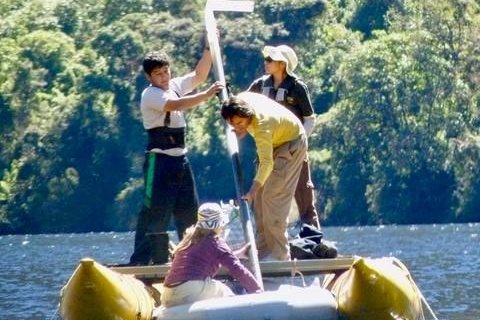Researchers collected sediment cores from the bottom of the Lake of the Condors in Peru. The core's data helped scientists reconstruct a 2,100-year record of climate and land-use change in the region. Photo by
Florida Tech
Dec. 10 (UPI) -- Cloud forests are thick, high-elevation patches of mossy forest watered by the near-constant presence of fog and low-hanging clouds. These niche habitats are often thought of and described as pristine, but new research suggests cloud forests in the Peruvian Andes were cleared by
native Andean farmers some 1,200 years ago.
Today, cloud forests serve as a sanctuary for species chased to higher elevations by rising global temperatures and extreme weather. However, cloud forests themselves -- and the important ecological role they play -- are increasingly threatened by climate change.
According to new research, Peru's cloud forests have faced threats from climate change and human activity before.
To trace the history of human activity in and around the cloud forests that surround Peru's Lake of the Condors, scientists collected sediment cores from the bottom of the lake. By measuring the changing concentrations of fossil pollen, charcoal and algae, as well as shifts in sediment chemistry, researchers were able to reconstruct the history of land-use in the region.
Scientists knew that native populations had occupied the forests surrounding the Lake of the Condors, as archaeologists have found more than 200 Incan and pre-Incan mummies entombed in the cliffs above the lake.
The latest analysis, published this week in the journal Nature Ecology and Evolution, showed the region also hosted high-elevation farming.
When scientists compared their sediment data with ancient climate patterns, they found a series of long-lasting droughts called megadroughts coincided with increases in cloud forest deforestation.
While the surrounding valley was drying up, the cloud forests remained moist. Native farmers cleared the forests to plant and harvest maize. The data showed deforestation peaked around 800 A.D. The last period of deforestation began around 1100 A.D. and ended a century later.
Some of the megadroughts lasted as long as a decade. In between dry periods, when precipitation levels rebounded, farmers allowed the forest to regrow and returned to their low-elevation fields. But the farmers would return when another megadrought arrived.
Farmers stopped clearing cloud forests for good around the same time the drought pattern ceased and the region grew wetter. About the same time, Andean societies began using the cliffs for burials.
"As the landscape changed from a patchwork of maize fields and disturbed forests back to cloud forest, we saw an end to burning and an almost immediate improvement in the lake's water quality," lead researcher Mark Bush, a professor of biology at the Florida Institute of Technology, said in a news release. "This recovery offers us the hope that some of the bad ecosystem impacts from deforestation and grazing in the Andes are reversible."
Some of the megadroughts lasted as long as a decade. In between dry periods, when precipitation levels rebounded, farmers allowed the forest to regrow and returned to their low-elevation fields. But the farmers would return when another megadrought arrived.
"We were surprised to see how responsive these populations were to climate change," said lead study author Christine Åkesson, who conducted the study as a doctoral student at Florida Tech. "We expected to see a steady rise in land use peaking with the internment of mummies in the cliffs and the collapse of Incan society when the Spanish conquered this part of Peru in the 1570s, but that isn't what happened."















